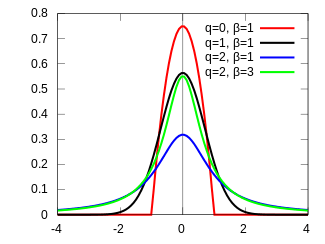q-Gaussian distribution
|
Probability density function
| |
| Parameters |
shape (real) (real) |
|---|---|
| Support |
for for |
| Mean | , otherwise undefined |
| Median | |
| Mode | |
| Variance |
|
| Skewness | |
| Ex. kurtosis | |
The q-Gaussian is a probability distribution arising from the maximization of the Tsallis entropy under appropriate constraints. It is one example of a Tsallis distribution. The q-Gaussian is a generalization of the Gaussian in the same way that Tsallis entropy is a generalization of standard Boltzmann–Gibbs entropy or Shannon entropy.[1] The normal distribution is recovered as q → 1.
The q-Gaussian has been applied to problems in the fields of statistical mechanics, geology, anatomy, astronomy, economics, finance, and machine learning. The distribution is often favored for its heavy tails in comparison to the Gaussian for 1 < q < 3. A generalized q-analog of the classical central limit theorem[2] was proposed in 2008, in which the independence constraint for the i.i.d. variables is relaxed to an extent defined by the q parameter, with independence being recovered as q → 1. However, a proof of such a theorem is still lacking.[3]
In the heavy tail regions, the distribution is equivalent to the Student's t-distribution with a direct mapping between q and the degrees of freedom. A practitioner using one of these distributions can therefore parameterize the same distribution in two different ways. The choice of the q-Gaussian form may arise if the system is non-extensive, or if there is lack of a connection to small samples sizes.
Characterization
Probability density function
The q-Gaussian has the probability density function [2]
where
is the q-exponential and the normalization factor is given by
Entropy
Just as the normal distribution is the maximum information entropy distribution for fixed values of the first moment and second moment (with the fixed zeroth moment corresponding to the normalization condition), the q-Gaussian distribution is the maximum Tsallis entropy distribution for fixed values of these three moments.
Related distributions
Student's t-distribution
While it can be justified by an interesting alternative form of entropy, statistically it is a scaled reparametrization of the Student's t-distribution introduced by W. Gosset in 1908 to describe small-sample statistics. In Gosset's original presentation the degrees of freedom parameter ν was constrained to be a positive integer related to the sample size, but it is readily observed that Gosset's density function is valid for all real values of ν. The scaled reparametrization introduces the alternative parameters q and β which are related to ν.
Given a Student's t-distribution with ν degrees of freedom, the equivalent q-Gaussian has
with inverse
Whenever , the function is simply a scaled version of Student's t-distribution.
It is sometimes argued that the distribution is a generalization of Student's t-distribution to negative and or non-integer degrees of freedom. However, the theory of Student's t-distribution extends trivially to all real degrees of freedom, where the support of the distribution is now compact rather than infinite in the case of ν < 0.
Three-parameter version
As with many distributions centered on zero, the q-gaussian can be trivially extended to include a location parameter μ. The density then becomes defined by
Generating random deviates
The Box–Muller transform has been generalized to allow random sampling from q-gaussians.[4] The standard Box–Muller technique generates pairs of independent normally distributed variables from equations of the following form.
The generalized Box–Muller technique can generates pairs of q-gaussian deviates that are not independent. In practice, only a single deviate will be generated from a pair of uniformly distributed variables. The following formula will generate deviates from a q-Gaussian with specified parameter q and
where is the q-logarithm and
These deviates can be transformed to generate deviates from an arbitrary q-Gaussian by
Applications
Physics
It has been shown that the momentum distribution of cold atoms in dissipative optical lattices is a q-Gaussian.[5]
Finance
Financial return distributions in the New York Stock Exchange, NASDAQ and elsewhere have been interpreted as q-Gaussians.[6][7]
See also
- Constantino Tsallis
- Tsallis statistics
- Tsallis entropy
- Tsallis distribution
- q-exponential distribution
Notes
- ↑ Tsallis, C. Nonadditive entropy and nonextensive statistical mechanics-an overview after 20 years. Braz. J. Phys. 2009, 39, 337–356
- 1 2 Umarov, Sabir; Tsallis, Constantino; Steinberg, Stanly (2008). "On a q-Central Limit Theorem Consistent with Nonextensive Statistical Mechanics" (PDF). Milan j. math. Birkhauser Verlag. 76: 307–328. doi:10.1007/s00032-008-0087-y. Retrieved 2011-07-27.
- ↑ Hilhorst, H.J. (2010), "Note on a q-modified central limit theorem", Journal of Statistical Mechanics: Theory and Experiment, 2010 (10): P10023, arXiv:1008.4259
 , doi:10.1088/1742-5468/2010/10/P10023.
, doi:10.1088/1742-5468/2010/10/P10023. - ↑ W. Thistleton, J.A. Marsh, K. Nelson and C. Tsallis, Generalized Box–Muller method for generating q-Gaussian random deviates, IEEE Transactions on Information Theory 53, 4805 (2007)
- ↑ Douglas, P.; Bergamini, S.; Renzoni, F. (2006). "Tunable Tsallis Distributions in Dissipative Optical Lattices". Physical Review Letters. 96 (11). doi:10.1103/PhysRevLett.96.110601.
- ↑ L. Borland, Option pricing formulas based on a non-Gaussian stock price model, Phys. Rev. Lett. 89, 098701 (2002)
- ↑ L. Borland, The pricing of stock options, in Nonextensive Entropy – Interdisciplinary Applications, eds. M. Gell-Mann and C. Tsallis (Oxford University Press, New York, 2004)
Further reading
- Juniper, J. (2007) "The Tsallis Distribution and Generalised Entropy: Prospects for Future Research into Decision-Making under Uncertainty", Centre of Full Employment and Equity, The University of Newcastle, Australia
